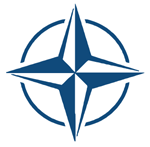roundels
 French Air Service WWI, Royal Air Force WWI-present, Royal Canadian Air Force 1946-67, 1967-present
French Air Service WWI, Royal Air Force WWI-present, Royal Canadian Air Force 1946-67, 1967-present
Roundels are identifying insignias, usually in military use, meant for easy identification of vehicles and aircraft. Roundel is a heraldic term: circle. The French Air Force was the first to use this identification system in WWI: the tricolour in a 1:2:3 proportion. The Royal Flying Corps followed, with the colours reversed. All the Commonwealth air forces used the RAF roundel until 1946 when they were redesigned for specific countries.
The RCAF roundel from 1946-1967 used a winsome maple leaf; after that, it became the maple leaf of the flag.
 Australia, New Zealand, Rhodesia, South Africa 1927-46, 1947-57The Royal Australian Air Force put a red kangaroo in the centre of its roundel; the RNZAF a kiwi. After 1946 Rhodesia put three spears over the centre of the RAF roundel; the South African Air Force, from 1927-1947, an orange centre, from 1947-57 an orange springbok. Now the South African roundel is very complicated: an eagle over a scalloped fort shape.
Australia, New Zealand, Rhodesia, South Africa 1927-46, 1947-57The Royal Australian Air Force put a red kangaroo in the centre of its roundel; the RNZAF a kiwi. After 1946 Rhodesia put three spears over the centre of the RAF roundel; the South African Air Force, from 1927-1947, an orange centre, from 1947-57 an orange springbok. Now the South African roundel is very complicated: an eagle over a scalloped fort shape.
The original striped roundels were clearly for wartime identification when recognition must be instant and if the markings are indistinct, lethal. Also, the Allies were all pulling together under the RAF, thus they mostly used the RAF insignia. WW2 was the last gasp of the British Empire, after it came the waves of decolonisation, 'empire' became an unuseable term, replaced by the more anodyne Commonwealth which today is almost without meaning — even the beautiful 1962 Commonwealth Institute building in London (listed Grade II) is now occupied by the Design Museum. Commonwealth declarations of national identity within the dark blue border of the old British empire were a slow transition to contemporary warfare where, for example, the Canadian Forces operate under NATO command, whose roundel seems, graphically speaking, very ambiguous.

